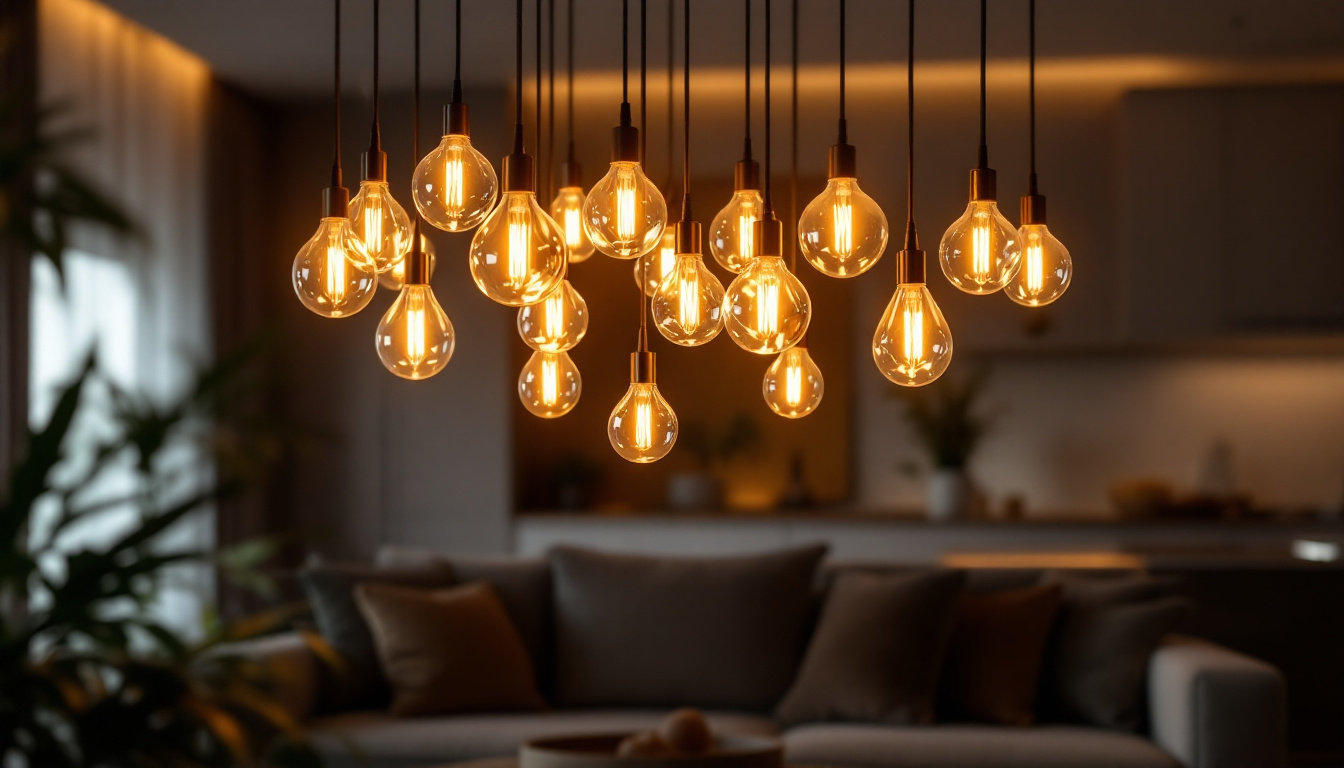
In the world of lighting, understanding the various components and specifications is crucial for contractors. One of the most common elements encountered is the large light bulb base. This article aims to address some of the frequently asked questions surrounding large light bulb bases, providing clarity and insights for lighting contractors.
Large light bulb bases are essential in ensuring that bulbs fit securely into fixtures. These bases come in various sizes and types, each designed for specific applications. Understanding the characteristics of these bases can help contractors make informed decisions when selecting bulbs for their projects.
There are several types of large light bulb bases commonly used in the industry. The most prevalent include the E26, E39, and E40 bases. Each of these bases has unique features that cater to different lighting needs.
The E26 base, also known as the medium base, is widely used in residential and commercial applications. It is compatible with a vast range of bulbs, including incandescent, LED, and CFL options. On the other hand, the E39 and E40 bases are larger and primarily used in industrial and commercial settings, often for high-intensity discharge (HID) lamps.
In addition to these common types, there are also specialized bases like the R7s and G12, which serve specific purposes in stage lighting and specialty fixtures. The R7s base, for instance, is a linear base often used in floodlights and wall washers, providing a powerful light source for outdoor events or large spaces. The G12 base, on the other hand, is frequently found in compact fluorescent lamps and LED fixtures, offering versatility in both residential and commercial lighting solutions.
Compatibility between the bulb and the fixture is critical. Using the wrong base type can lead to improper fitment, which may cause flickering, overheating, or even damage to the fixture. Contractors should always verify the base type required for each specific application to ensure optimal performance and safety.
Furthermore, understanding the wattage and voltage ratings associated with each base type is equally important. For example, while an E26 base can accommodate bulbs ranging from 40 watts to 100 watts, exceeding these limits can pose fire hazards or reduce the lifespan of the bulb. Additionally, the electrical characteristics of the fixture must match the specifications of the bulb to maintain energy efficiency and prevent potential electrical issues. This attention to detail not only enhances the longevity of the lighting system but also contributes to overall energy savings in the long run, making it a crucial consideration for contractors and property owners alike.
Lighting contractors often encounter various questions regarding large light bulb bases. Here are some of the most common inquiries and their corresponding answers.
The primary difference between E26 and E39 bases lies in their size and application. The E26 base has a diameter of 26 millimeters, making it suitable for standard residential and commercial lighting. In contrast, the E39 base measures 39 millimeters in diameter, designed for larger fixtures typically used in industrial settings.
Additionally, E39 bases are often used with higher wattage bulbs, which require more robust electrical connections. Understanding these differences helps contractors select the appropriate base for their specific lighting needs. For instance, E39 bases are frequently found in high-bay lighting applications, where bright illumination is essential for warehouses and manufacturing facilities. The choice of base can significantly impact the efficiency and effectiveness of the lighting solution provided.
While it is technically possible to use an adapter to convert between different base types, it is generally not recommended. Adapters can introduce risks such as poor electrical connections, increased heat generation, and potential safety hazards.
Instead, it is advisable to select the correct bulb base for the fixture in question. This approach ensures a secure fit and optimal performance, reducing the likelihood of complications down the line. Moreover, using the appropriate base can prevent voiding warranties on fixtures or bulbs, which can be a significant concern for contractors and their clients. Ensuring compatibility from the outset can save time and resources in the long run, allowing for a smoother installation process.
Yes, there are numerous energy-efficient options available for large light bulb bases. LED bulbs have become increasingly popular due to their energy efficiency and long lifespan. Many manufacturers now offer LED bulbs designed to fit E26, E39, and E40 bases, providing contractors with a sustainable lighting solution.
Switching to energy-efficient bulbs not only reduces energy consumption but also lowers maintenance costs over time. Contractors should consider recommending these options to clients looking to enhance their lighting systems while being environmentally conscious. Additionally, many LED options come with advanced features such as dimming capabilities and smart technology integration, allowing for greater control over lighting environments. This adaptability can be particularly beneficial in commercial spaces where lighting needs may vary throughout the day, providing both functionality and energy savings in one solution.
Proper installation of large light bulb bases is essential for ensuring safety and functionality. Here are some tips to keep in mind during the installation process.
Before beginning any installation, it is crucial to turn off the power to the fixture. This step minimizes the risk of electrical shock and ensures a safe working environment. Always double-check with a voltage tester to confirm that the power is indeed off before proceeding. Additionally, it’s wise to inform anyone in the vicinity that you are working on the electrical system to prevent accidental reactivation of the power supply.
As mentioned earlier, verifying compatibility between the bulb and the fixture is vital. Contractors should carefully inspect the base type and wattage requirements before installation. This diligence helps prevent issues related to overheating or electrical malfunctions. It’s also beneficial to consult the manufacturer’s specifications for both the bulb and the fixture, as they often provide invaluable insights into the optimal performance and safety standards for the products being used.
When installing the bulb, ensure it is securely fastened into the base. A loose connection can lead to flickering lights or even damage to the fixture. Contractors should apply gentle pressure while twisting the bulb into place, ensuring a snug fit without overtightening, which could cause breakage. Moreover, consider using a cloth or rubber grip to help with the installation, as this can provide better leverage and prevent any accidental slippage during the process.
When installing large light bulb bases, it’s also important to consider the environment in which the fixture will be used. For instance, if the fixture is located in a damp area, such as a bathroom or outdoor space, ensure that the bulb is rated for such conditions. Using bulbs that are specifically designed for moisture resistance can prevent premature failure and enhance safety. Furthermore, think about the color temperature of the bulb; warmer tones can create a cozy atmosphere, while cooler tones are often better suited for task lighting.
After installation, regular maintenance checks can help ensure the longevity and performance of the light fixture. Periodically inspect the bulb and base for any signs of wear or damage, such as discoloration or corrosion. Additionally, cleaning the fixture and bulb can improve light output and efficiency. Dust and debris can accumulate over time, diminishing the overall brightness and potentially leading to overheating. By keeping the area clean and well-maintained, you can enjoy optimal lighting conditions for years to come.
Regular maintenance of lighting fixtures is essential for longevity and performance. Contractors should be aware of several key maintenance considerations when dealing with large light bulb bases.
Conducting regular inspections of lighting fixtures can help identify potential issues before they escalate. Look for signs of wear and tear, such as discoloration or corrosion around the base. These indicators may suggest that the bulb or fixture needs replacement.
Additionally, checking for loose connections or damaged wiring can prevent safety hazards and ensure optimal performance of the lighting system.
Dust and debris can accumulate on light fixtures over time, affecting their performance and aesthetics. Contractors should recommend periodic cleaning of fixtures to maintain their appearance and functionality. Use a soft cloth and a mild cleaning solution to gently wipe down the surfaces, taking care not to damage any electrical components.
When a bulb burns out, it is essential to replace it promptly. Continuing to use a fixture with a burnt-out bulb can lead to increased strain on the remaining bulbs, potentially causing them to fail prematurely. Contractors should encourage clients to keep spare bulbs on hand for quick replacements.
Safety should always be a top priority when working with electrical components. Here are some essential safety precautions for contractors to consider.
Contractors should always wear appropriate personal protective equipment when working with electrical fixtures. This includes safety goggles to protect the eyes from debris, gloves to prevent electrical shock, and non-slip footwear for stability.
Adhering to local electrical codes and regulations is crucial for ensuring safety and compliance. Contractors should familiarize themselves with the relevant codes in their area and ensure that all installations meet these standards.
Contractors play a vital role in educating clients about safety practices related to lighting fixtures. Providing clients with information on how to safely replace bulbs and maintain their lighting systems can help prevent accidents and ensure a safe environment.
Understanding large light bulb bases is essential for lighting contractors looking to provide quality service to their clients. By addressing common questions, installation tips, maintenance considerations, and safety precautions, contractors can enhance their expertise and deliver optimal lighting solutions.
As the industry continues to evolve, staying informed about the latest trends and technologies will further empower contractors to make informed decisions. Embracing energy-efficient options and adhering to safety standards will not only benefit clients but also contribute to a sustainable future in lighting.
Ready to elevate your lighting projects with the best in spec-grade lighting products? Look no further than LumenWholesale for all your large light bulb base needs and more. Our commitment to quality and affordability ensures you have access to a wide range of reliable lighting options, all at unbeatable wholesale prices. Say goodbye to the middleman and hello to cost savings, free shipping, and the convenience of bulk buying. Don’t compromise on your lighting solutions—choose LumenWholesale for the perfect blend of quality, affordability, and convenience. Wholesale Lighting at the Best Value is just a click away.

Discover the transformative advantages of LED lighting chandeliers for lighting contractors.

Discover the often-overlooked aspects of bollard lights that every lighting contractor should know.

Discover the essential role outdoor lights play in garage lighting installations.

Discover the essential answers to lighting contractors’ most common questions about F32T8 ballasts.